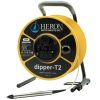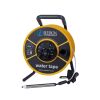Solinst Model 101D Water Level DrawDown Meters
Features
- Both static water level and drawdown modes in one meter
- One convenient toggle makes it easy to switch between two functions
- Uses the same robust, submersible probe as the 101 P7 Water Level Meter
- Free ground shipping
- Expedited repair and warranty service
- Lifetime technical support
- More
Overview
The Solinst 101D Water Level DrawDown Meter has all of the same qualities as the well-known 101 P7 Water Level Meter, with the added feature of a drawdown mode. One simple toggle switches between static water level and drawdown measurements. Water level mode allows accurate depth to water measurements in wells, boreholes, standpipes and tanks. The drawdown function is used to monitor falling hydraulic head during low flow sampling, pumping and other aquifer/well tests. It also ensures a pump’s intake remains submerged during purging or well development.
Mechanics
The 101D Water Level DrawDown Meter uses a corrosion-resistant stainless steel probe connected to clearly marked flat tape, fitted on a well-designed reel. It is powered by a standard 9 volt battery. In water level mode, when the zero point on the probe enters water, an electronic circuit is completed, activating the buzzer and light. The depth to water is then read off the tape. In drawdown mode, the circuit is reversed—the buzzer and light are triggered when the probe is in air. The battery test button can check the circuit in both water level and drawdown modes. The on/off sensitivity control allows the buzzer to be turned down in cascading water and ensures a clear signal in high and low conductivity conditions.
- (1) Model 101D Water Level DrawDown Meter
- (1) Tape guide/datum
In The News
Wildfire Prevention in the Sierra Nevada Region with the Yuba Watershed Institute
Though recent wildfires have sparked new conversations about wildfire management and response, groups like the Yuba Watershed Institute have been monitoring the forests and water resources of the Sierra Nevada region for decades, managing approximately 5,000 acres of land with the Bureau of Land Management (BLM) and about 7,000 acres in private land partnerships. The goal of the Institute is to work with local communities and land agencies to improve watershed and forestry management through informed practices and public outreach. The goals of the Yuba Watershed Institute are three-fold: Improve the ability of fire suppression agencies like the California Department of Forestry and Fire Protection ( CAL FIRE ) and the US Forest Service.
Read MoreWave Sensors Integration with NexSens Buoys: A Cutting-Edge Solution for Wave Measurment
Real-time wave data supports accurate weather prediction, safe and efficient maritime operations, and provides valuable safety and operating condition information for recreation and commercial fishing. Understanding wave dynamics also helps with the design of protective coastal structures like seawalls, breakwaters, and jetties. It also supports better prediction of their impact on sediment transport and coastal geomorphology. Wave data is a key factor in qualifying and designing offshore wind farms and harnessing kinetic energy for electrical generation. It helps with the understanding of ocean-atmosphere interactions and contributes to studies of sea-level rise and climate change impacts.
Read MoreSpring 2025 Environmental Monitor Available Now
In the Spring 2025 edition of the Environmental Monitor, we highlight partnerships across the world and the importance of collaboration between government agencies, universities, environmental groups, local communities, and other stakeholders. From great white shark research in Cape Cod to monitoring fisheries in Lake Erie, this latest edition underscores partnerships that connect stakeholders in a watershed through environmental data. With an emphasis on data sharing, a combination of real-time and discrete sampling keeps the public and partners informed of environmental conditions. Our writers also sought out science professionals dedicated to working with peers within and outside of the environmental sector.
Read More






























